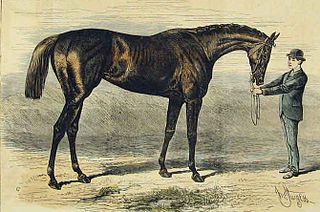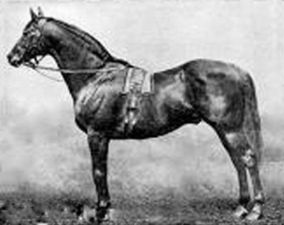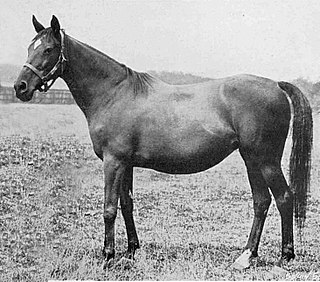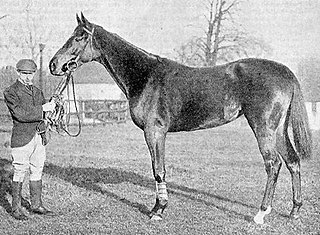
Ormonde (1883–1904) was an English Thoroughbred racehorse who won the English Triple Crown in 1886 and retired undefeated. He also won the St. James's Palace Stakes, Champion Stakes and the Hardwicke Stakes twice. At the time he was often labelled as the 'horse of the century'. Ormonde was trained at Kingsclere by John Porter for the 1st Duke of Westminster. His regular jockeys were Fred Archer and Tom Cannon. After retiring from racing he suffered fertility problems, but still sired Orme, who won the Eclipse Stakes twice.

Bend Or (1877–1903) was a British Thoroughbred racehorse who won the 1880 Epsom Derby. His regular jockey Fred Archer, winner of thirteen consecutive British jockey titles, said Bend Or was probably the greatest horse he had ever ridden.

Diamond Jubilee was a British-bred and British-trained Thoroughbred race horse and sire. In a career which lasted from June 1899 until October 1901 he ran sixteen times and won six races.

Shotover (1879–1898) was a British Thoroughbred racehorse and broodmare. In a career that lasted from 1882 to 1884, she ran 15 times and won five races. As a three-year-old, racing against colts, she became the first filly to win the first two legs of the English Triple Crown: the 2000 Guineas at Newmarket and the Derby at Epsom. She went on to win twice at Royal Ascot, but failed in her bid for the Triple Crown when she finished third in the St Leger at Doncaster. She was retired in 1884 and became a successful and influential broodmare. Shotover died in 1898.

St. Blaise (1880–1909) was a British Thoroughbred racehorse and sire. In a career that lasted from 1882 to 1884 he ran twelve time and won seven races, although three of these wins were walk-overs. His most important success came in 1883 when he won The Derby. At the end of the season he was sold and exported to the United States to stand as a stallion where he had some success. St. Blaise was killed in a fire in 1909.

La Fleche (1889–1916) was a British Thoroughbred racehorse and broodmare. After being sold for a world record price as a yearling in 1890, she was undefeated as a two-year-old in 1891, winning races against her own sex and defeating some of the year's leading colts. She went on to become the dominant British three-year-old of 1892, claiming the Fillies’ Triple Crown by winning the 1000 Guineas at Newmarket, the Oaks at Epsom and the St Leger at Doncaster. Her only defeat of the year came when she finished second when starting favourite for The Derby.

Orme was a British Thoroughbred racehorse. He was trained at Kingsclere by John Porter for the 1st Duke of Westminster. As a two-year-old he won the Middle Park and Dewhurst Stakes. As a three-year-old he was not well enough to take part in the 2000 Guineas and Epsom Derby, but came back to win the Eclipse Stakes. Orme stayed in training as a four-year-old and won another Eclipse Stakes, becoming the first horse to win the race twice, a feat that has only been repeated four times since. After he had retired from racing, he became a successful sire and was Champion sire of Great Britain in 1899. His son Flying Fox won the Triple Crown and the Eclipse Stakes. Orme also sired Epsom Derby winner Orby and 1000 Guineas winner Witch Elm. His regular jockeys were George Barrett and Morny Cannon.

Friar's Balsam (1885–1899) was an English Thoroughbred racehorse. He was the outstanding British two-year-old of 1887, when he was unbeaten in seven races. He was a sick horse when a beaten favourite in the following year's 2000 Guineas, but returned in the autumn to beat Minting in the Champion Stakes. Friar's Balsam was retired to stud where he had some success as a sire of winners. He was trained at Kingsclere by John Porter for Lord Alington and Sir Frederick Johnstone.

Ossory (1885-1889) was a Thoroughbred racehorse. He was trained at Kingsclere by John Porter for the 1st Duke of Westminster. As a three-year-old he won the Prince of Wales's Stakes and St. James's Palace Stakes at Royal Ascot.

Orbit was a Thoroughbred racehorse. He was trained at Kingsclere by John Porter for the 1st Duke of Westminster. As a three-year-old he won the Eclipse Stakes.

William the Third (1898–1917) was a British Thoroughbred racehorse and sire. After finishing unplaced on his only race as a two-year-old in 1900, he won five times in 1901 as well as finishing second in The Derby. He reached his peak as a four-year-old, winning five consecutive races including the Ascot Gold Cup, Queen Alexandra Stakes and Doncaster Cup. His career was ended by injury in early 1903 and he was retired to stud, where he had considerable success as a sire of winners.

Pilgrimage (1875–1897) was a British Thoroughbred racehorse. As a two-year-old she was only defeated once and won the Dewhurst Plate. She only raced three times as a three-year-old, winning the 2000 Guineas and 1000 Guineas, before finishing as the runner-up in the Oaks Stakes. After retiring from racing she became a successful broodmare, foaling Oaks winner Canterbury Pilgrim and Derby winner Jeddah.
Desmond was a British Thoroughbred racehorse and sire. He was at his peak as a two-year-old in the early summer of 1898 when he won three races in quick succession including the Coventry Stakes and the July Stakes. He never won again and was retired from racing at the end of the following year. He later became a very successful breeding stallion and was the Leading sire in Great Britain and Ireland in 1913, the year of his death.

Elm Park is a British Thoroughbred racehorse. As a two-year-old he became regarded as a leading contender for the 2015 British Classic Races after wins in the Royal Lodge Stakes and the Racing Post Trophy. In 2015 he finished third to Golden Horn and Jack Hobbs in the Dante Stakes but finished unplaced in The Derby. He later won the listed Fortune Stakes.

La Roche was a British Thoroughbred racehorse and broodmare. As a two-year-old in 1899 she showed some promise, winning once from six attempts, but appeared to be some way below top class. In the following season, when tried over longer distance, she emerged as one of the best horses of her generation in England, winning the Oaks Stakes, Manchester Cup, Yorkshire Oaks and Newmarket Oaks as well as finishing fourth in the 1000 Guineas and third in the Doncaster Cup. She was retired at the end of the season to become a broodmare and had considerable success as a dam of winners.

Nun Nicer (1895–1915) was a British Thoroughbred racehorse and broodmare. As a two-year-old in 1897 she ran consistently, winning three of her nine races including the Manchester Summer Foal Plate and Hopeful Stakes as well as being placed on four occasions. In the following year she won the 1000 Guineas, Triennial Stakes, September Stakes and Palatine Plate and finished second in the Epsom Oaks and Coronation Stakes. As a four-year-old she ran second in the Stewards' Cup and won the Preis von Donausschingen in Germany. She made no impact as a broodmare.

Airs and Graces was a British Thoroughbred racehorse and broodmare. As a two-year-old she raced in the colours of the 6th Duke of Portland and showed modest ability, winning one minor race. After being bought by the Australian sportsman W T Jones she showed much improved form at three in 1898, winning the Epsom Oaks and being placed in both the 1000 Guineas and the Coronation Stakes. She failed to win a race in 1900 but ran well to finish second in the Cambridgeshire Handicap. She was exported to France to become a broodmare and produced two top-class winners.
Throstle was a British Thoroughbred racehorse and broodmare. Born partially blind and considered a likely candidate for euthanasia as a foal she nevertheless proved herself one of the two best fillies of her generation in Britain. She showed considerable promise despite failing to win in three starts as a juvenile in 1893 and began her second season by running sixth to Amiable in the 1000 Guineas. In the summer of her second season she made rapid progress, winning the Coronation Stakes and Nassau Stakes as well as finishing fourth against very strong male opposition in the Eclipse Stakes. Poor form in training led to her starting at odds of 50/1 for the St Leger but she created a huge upset by defeating the Epsom Derby winner Ladas. She failed to win again and was retired from racing in 1895. She had little success as a dam of winners.

Surefoot was a British Thoroughbred racehorse and sire whose exceptional racing ability was combined with a violent and unpredictable temperament. As a juvenile in 1889 he was regarded as the best colt of his generation in England after winning three of his four races including the Woodcote Stakes and New Stakes. He also demonstrated his precocity by reportedly siring a foal as a two-year-old. In 1890 he was an emphatic winner of the 2000 Guineas but despite being regarded as a near certainty for the Epsom Derby he finished fourth after spending much of the race attempting to savage other horses and jockeys. He went on to win a minor race at Royal Ascot and later defeated a strong field to take the valuable Prince of Wales' Stakes at Leicester Racecourse. As a four-year-old he showed little worthwhile form early in the season but returned to his best to win the Eclipse Stakes. After his retirement from racing he stood as a breeding stallion in England and France but had limited success as a sire of winners.
Reve d'Or was a British Thoroughbred racehorse and broodmare who won two British Classic Races in 1887. She ran nine times as a juvenile in 1886, winning three races including an upset victory in the Dewhurst Plate in October. In the following year she won nine races including the 1000 Guineas, Oaks Stakes, Sussex Stakes, York Queen's Plate, Yorkshire Oaks, Great Foal Stakes and Newmarket Oaks. She remained in training until the age of seven, winning the Jockey Club Cup in 1888 and the City and Suburban Handicap in 1890. She had limited success as a broodmare in France.
















